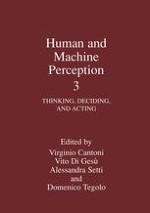
2001 | OriginalPaper | Buchkapitel
From Computing With Numbers to Computing With Words - From Manipulation of Measurements to Manipulation of Perceptions
verfasst von : Lotfi A. Zadeh
Erschienen in: Human and Machine Perception 3
Verlag: Springer US
Enthalten in: Professional Book Archive
Aktivieren Sie unsere intelligente Suche, um passende Fachinhalte oder Patente zu finden.
Wählen Sie Textabschnitte aus um mit Künstlicher Intelligenz passenden Patente zu finden. powered by
Markieren Sie Textabschnitte, um KI-gestützt weitere passende Inhalte zu finden. powered by
Computing, in its usual sense, is centered on manipulation of numbers and symbols. Incontrast, computing with words, or CW for short, is a methodology in which the objects of computation are words and propositions drawn from a natural language, e.g., small, large,far, heavy, not very likely, the price of gas is low and declining, Berkeley is near San Francisco, it is very unlikely that there will be a significant increase in the price of oil in the near future, etc. Computing with words is inspired by the remarkable human capability to perform a wide variety of physical and mental tasks without any measurements and any computations. Familiar examples of such tasks are parking a car, driving in heavy traffic,playing golf, riding a bicycle, understanding speech and summarizing a story. Underlying this remarkable capability is the brain’s crucial ability to manipulate perceptions- perceptions of distance, size, weight, color, speed, time, direction, force, number, truth,likelihood and other characteristics of physical and mental objects. Manipulation of perceptions plays a key role in human recognition, decision and execution processes. As a methodology, computing with words provides a foundation for a computational theory of perceptions - a theory which may have an important bearing on how humans make – and machines might make - perception-based rational decisions in an environment of imprecision, uncertainty and partial truth.A basic difference between perceptions and measurements is that, in general,measurements are crisp whereas perceptions are fuzzy. One of the fundamental aims of science has been and continues to be that of progressing from perceptions to measurements.Pursuit of this aim has led to brilliant successes. We have sent men to the moon; we can build computers that are capable of performing billions of computations per second; we have constructed telescopes that can explore the far reaches of the universe; and we can date the age of rocks that are millions of years old. But alongside the brilliant successes stand conspicuous underachievements and outright failures. We cannot build robots which can move with the agility of animals or humans; we cannot automate driving in heavy traffic;we cannot translate from one language to another at the level of a human interpreter; we cannot create programs which can summarize non-trivial stories; our ability to model the behavior of economic systems leaves much to be desired; and we cannot build machines that can compete with children in the performance of a wide variety of physical and cognitive tasks.It may be argued that underlying the underachievements and failures is the unavailability of a methodology for reasoning and computing with perceptions rather than measurements. An outline of such a methodology - referred to as a computational theory of perceptions - is presented in this paper. The computational theory of perceptions, or CTP for short, is based on the methodology of computing with words (CW). In CTP, words play the role of labels of perceptions and, more generally, perceptions are expressed as propositions in a natural language. CW-based techniques are employed to translate propositions expressed in a natural language into what is called the Generalized Constraint Language(GCL). In this language, the meaning of a proposition is expressed as a generalized constraint, X isr R, where X is the constrained variable, R is the constraining relation and isr is a variable copula in which r is a variable whose value defines the way in which R constrains X. Among the basic types of constraints are:possibilistic,veristic,probabilistic,random set, Pawlak set, fuzzy graph and usuality. The wide variety of constraints in GCL makes GCL a much more expressive language than the language of predicate logic.In CW, the initial and terminal data sets, IDS and TDS, are assumed to consist of propositions expressed in a natural language. These propositions are translated, respectively,into antecedent and consequent constraints. Consequent constraints are derived from antecedent constraints through the use of rules of constraint propagation. The principal constraint propagation rule is the generalized extension principle. The derived constraints are retranslated into a natural language, yielding the terminal data set (TDS). The rules of constraint propagation in CW coincide with the rules of inference in fuzzy logic. A basic problem in CW is that of explicitation of X, R and r in a generalized constraint, X isr R,which represents the meaning of a proposition, p, in a natural language.There are two major imperatives for computing with words. First, computing with words is a necessity when the available information is too imprecise to justify the use of numbers; and second, when there is a tolerance for imprecision which can be exploited to achieve tractability, robustness, low solution cost and better rapport with reality. Exploitation of the tolerance for imprecision is an issue of central importance in CW and CTP. At this juncture, the computational theory of perceptions - which is based on CW – is in its initial stages of development. In time, it may come to play an important role in the conception,design and utilization of information/ intelligent systems. The role model for CW and CTP is the human mind.